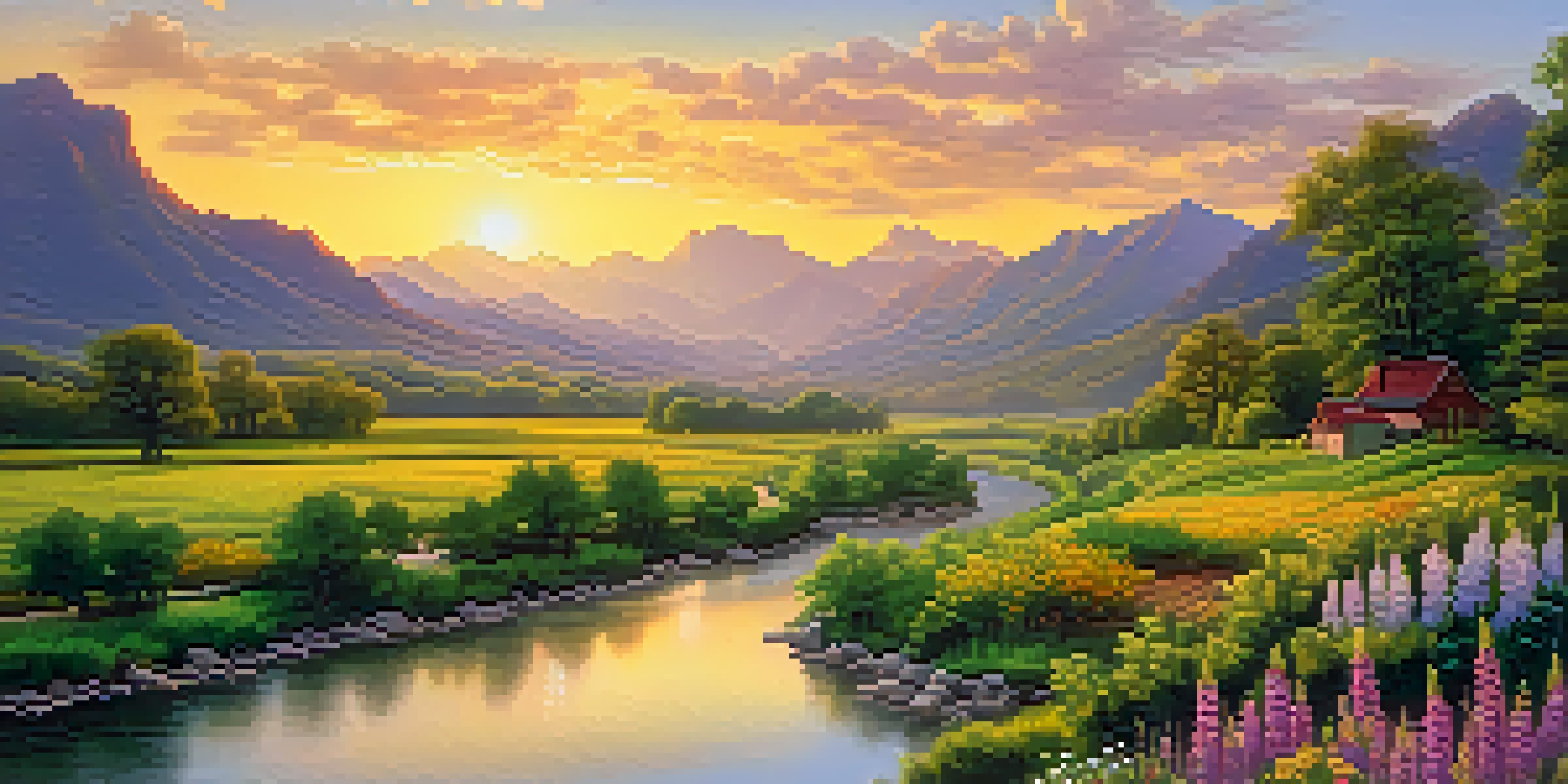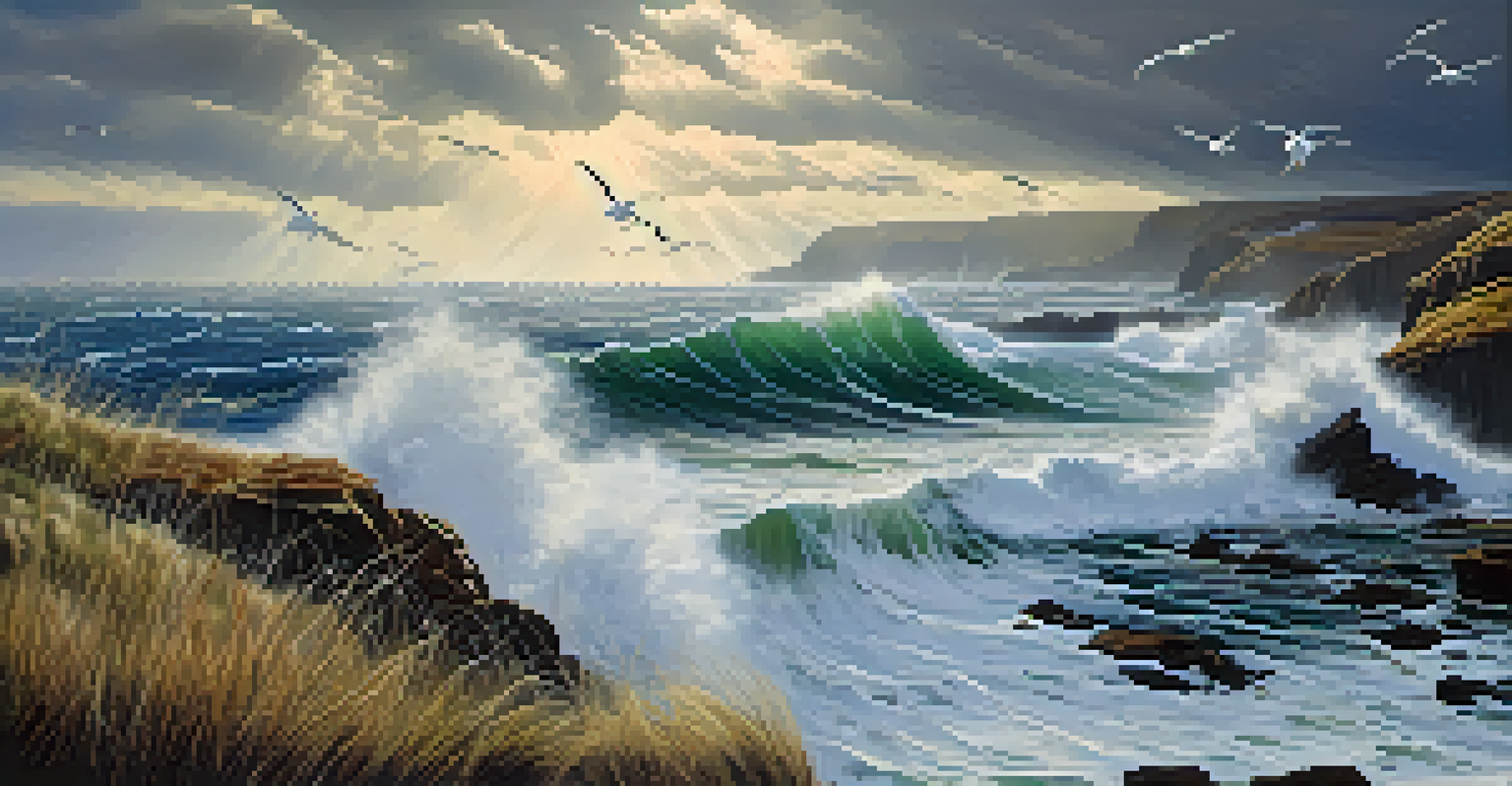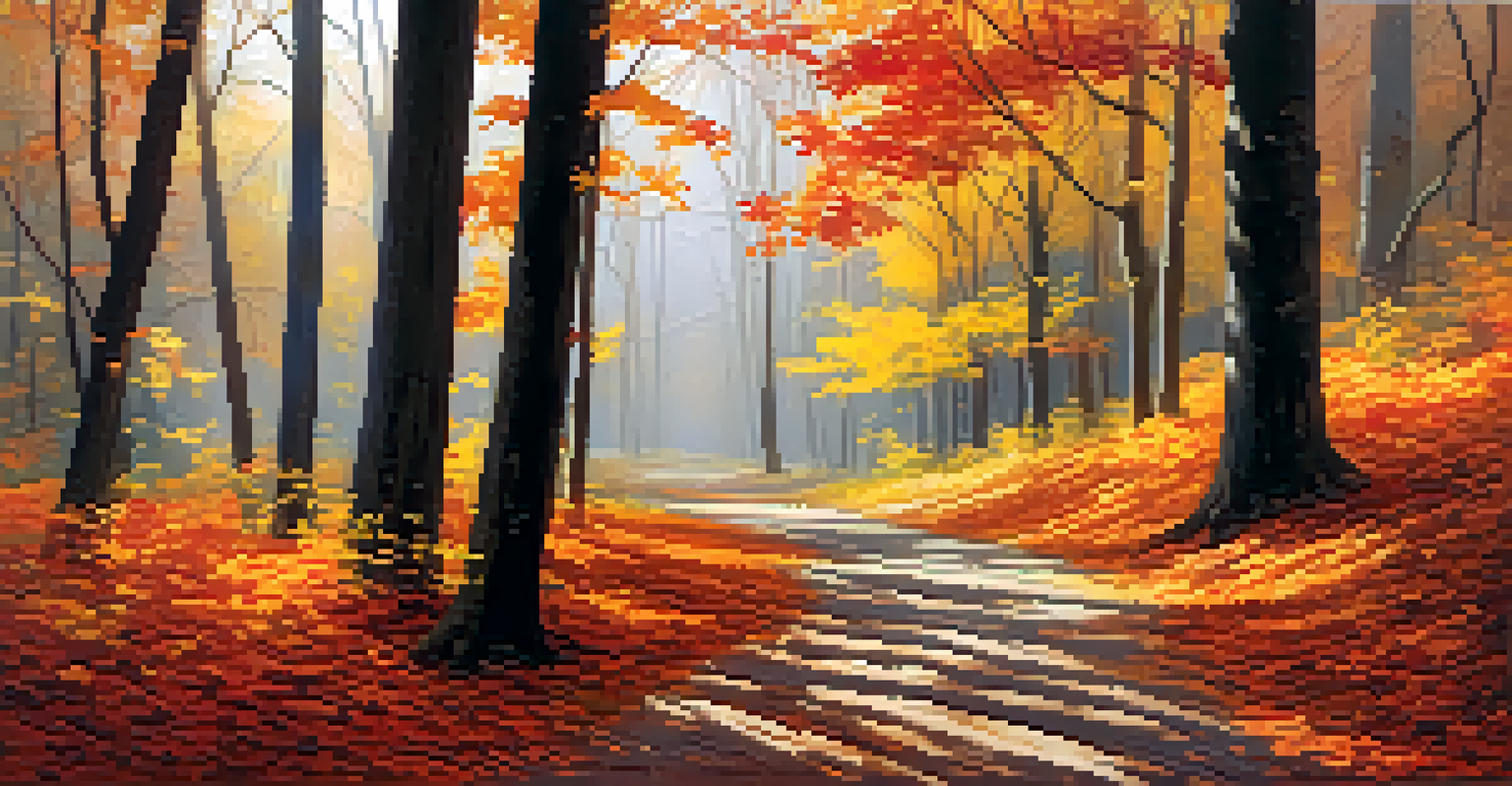The Evolution of Landscape Painting Across Different Cultures

Understanding Landscape Painting: A Cultural Overview
Landscape painting is an artistic genre that focuses on the depiction of natural scenery. It encompasses a range of elements like mountains, valleys, trees, rivers, and forests, often embodying the spirit of a specific place. This genre has been a means for artists to express their connection to the environment and the world around them, reflecting cultural values and beliefs.
Art is the most beautiful of all lies.
Across different cultures, landscape painting has served various purposes—from spiritual expression to social commentary. For instance, in ancient Chinese art, landscapes often carried philosophical meanings, emphasizing harmony with nature. This cultural context reveals how landscape painting is not just about aesthetics but also about conveying deeper messages.
As we delve into the evolution of landscape painting, it’s essential to recognize how geography, climate, and cultural identity shape artistic expressions. Each region’s unique characteristics influence how artists interpret and portray their surroundings, making landscape painting a rich tapestry of human experience.
The Origins of Landscape Painting in Ancient Civilizations
The roots of landscape painting can be traced back to ancient civilizations, such as the Egyptians and Greeks. In Egypt, artists depicted landscapes primarily as backdrops for religious narratives, showcasing the Nile's significance. These early representations reflected not just the physical landscape but also the cultural and spiritual importance of the environment.

Meanwhile, the Greeks advanced landscape painting by incorporating nature into their works in a more prominent way. They began to explore perspective and light, laying the groundwork for future artists to depict landscapes in more realistic and dynamic ways. This shift marked a pivotal moment in art history, where nature was celebrated as a worthy subject.
Cultural Significance of Landscapes
Landscape painting serves not only as a visual representation of nature but also as a reflection of cultural values and beliefs across different societies.
These early examples set the stage for landscape painting to evolve, as different cultures adapted and expanded upon these foundational ideas. The influence of ancient art can still be seen today, demonstrating how our relationship with nature has shaped artistic expression throughout time.
The Influence of Chinese Landscape Painting
Chinese landscape painting, known as 'shanshui,' translates to 'mountain-water' and carries profound philosophical significance. This art form emerged over a thousand years ago and emphasizes the relationship between humanity and nature, often expressing Taoist and Confucian ideals. The mountains and rivers depicted are not just physical landscapes; they symbolize harmony and balance.
The landscape belongs to the person who looks at it.
Artists like Fan Kuan and Guo Xi pioneered techniques that included intricate brushwork and the use of ink wash to create depth and texture. Their works often evoke a sense of tranquility, inviting viewers to reflect on their connection to nature. This focus on emotional resonance rather than mere representation differentiates Chinese landscape painting from many Western approaches.
The legacy of shanshui continues to influence contemporary artists, as it encourages them to explore themes of nature and spirituality. This enduring tradition highlights how cultural beliefs can shape artistic practices, offering a unique perspective on the evolution of landscape painting.
The Renaissance: A Turning Point in European Landscape Art
The Renaissance marked a significant turning point for landscape painting in Europe, with artists beginning to prioritize natural scenery in their works. Figures like Leonardo da Vinci and Raphael integrated landscapes into their compositions, showcasing a newfound appreciation for the beauty of the natural world. This era emphasized perspective and realism, allowing landscapes to take center stage.
As the Renaissance progressed, artists like Albrecht Dürer and Pieter Bruegel the Elder further explored landscape as a distinct genre. Their works captured not only the beauty of nature but also the daily lives of people within those landscapes, bridging the gap between human experience and the environment. This shift laid the groundwork for future movements that would celebrate landscapes more prominently.
Evolution Through Historical Eras
The evolution of landscape painting has been influenced by various historical periods, each introducing new techniques and perspectives that shaped artistic expression.
The impact of the Renaissance on landscape painting cannot be overstated, as it cultivated an enduring interest in capturing the natural world. This period laid the foundation for the evolution of landscape art, inspiring generations of artists to explore their surroundings with renewed curiosity and creativity.
Romanticism: Emotion and Nature in Landscape Art
The Romantic period of the late 18th and early 19th centuries brought a dramatic shift to landscape painting, emphasizing emotion and individual experience. Artists like Caspar David Friedrich and J.M.W. Turner depicted landscapes that evoked feelings of awe, sublime beauty, and even melancholy. Their works sought to communicate the power of nature and its ability to stir deep emotions within the viewer.
Romantic landscape paintings often feature dramatic skies, turbulent seas, and expansive vistas, symbolizing the unpredictability of nature. This focus on emotional impact marked a departure from the more structured approaches of previous eras, inviting viewers to connect with landscapes on a personal level. It was a celebration of both nature's grandeur and its capacity to inspire introspection.
The influence of Romanticism is still felt today, as artists continue to explore the emotional interplay between humanity and the natural world. This period not only transformed landscape painting but also encouraged a deeper appreciation for the beauty and complexity of the environment.
Impressionism: Capturing Fleeting Moments in Nature
The Impressionist movement of the late 19th century revolutionized landscape painting by focusing on capturing the effects of light and atmosphere. Artists like Claude Monet and Pierre-Auguste Renoir broke away from traditional techniques, opting for loose brushwork and vibrant colors to convey the transient beauty of nature. Their approach emphasized the momentary, allowing viewers to experience landscapes as they might appear in real life.
Impressionism encouraged artists to paint outdoors, directly engaging with their surroundings. This practice, known as 'plein air' painting, allowed them to capture the changing qualities of light and color in nature. This shift not only influenced the technical aspects of landscape painting but also inspired a more spontaneous and personal approach to art.
Modern Landscape Art and Ecology
Contemporary landscape painting increasingly addresses environmental concerns, urging viewers to consider their relationship with nature in a rapidly urbanizing world.
Through Impressionism, landscape painting became a dynamic expression of the artist's perception and feelings. The movement highlighted the relationship between light, nature, and emotion, paving the way for modern art and inspiring countless artists to explore new ways of seeing and representing the world around them.
Modern and Contemporary Landscape Painting: New Perspectives
In the 20th and 21st centuries, landscape painting has taken on diverse forms and meanings, reflecting the complexities of modern life. Artists like Georgia O'Keeffe and Ansel Adams expanded the boundaries of landscape art, exploring themes of abstraction and environmental awareness. Their works often convey a sense of urgency regarding ecological issues, prompting viewers to consider their relationship with nature.
Contemporary landscape painters often blend traditional techniques with new mediums, experimenting with photography, digital art, and installation. This evolution reflects the changing perception of landscapes in a rapidly urbanizing world, where natural spaces are increasingly threatened. Artists are now tasked with not just depicting beauty but also addressing environmental concerns through their work.

As we look to the future, the evolution of landscape painting continues to be shaped by cultural, technological, and environmental influences. This genre remains a vital form of expression, inviting us to reflect on our connection to the earth and our responsibility to protect it.